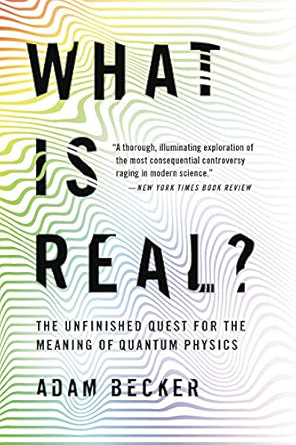More on this book
Community
Kindle Notes & Highlights
by
Adam Becker
Started reading
April 3, 2018
According to Born, von Neumann had proven that the Copenhagen interpretation was the only possible way of understanding quantum physics.
According to the Copenhagen interpretation, this question has a very simple answer: quantum physics tells us nothing whatsoever about the world.
Copenhagen interpretation states that quantum physics is merely a tool for calculating the probabilities of various outcomes of experiments.
electron is forced to a decision. We compel it to assume a definite position; previously, it was, in general, neither here nor there.… We ourselves produce the results of measurement.”
wave functions
The Schrödinger equation ensures that wave functions always change smoothly—the number that a wave function assigns to a particular location never hops instantly from 5 to 500. Instead, the numbers flow perfectly predictably: 5.1, 5.2, 5.3, and so on.
The wave function doesn’t tell you how much of the electron is in one place—it tells you the probability that the electron is in that place.
Somehow, the laws of physics seem to behave differently when you make a measurement: the Schrödinger equation holds all the time, except when you make a measurement, at which point the Schrödinger equation is temporarily suspended and the wave function collapses everywhere except a random
the measurement problem
Can anyone at all collapse a wave function? Do you need to be awake and conscious for it, or can a comatose person do it? What about a newborn baby? Is it limited to humans, or can chimps do it too? “When a mouse observes, does that change the [quantum] state of the universe?” Einstein once asked.
“Was the world wavefunction waiting to jump for thousands of millions of years until a single-celled living creature appeared? Or did it have to wait a little longer for some more highly qualified measurer—with a Ph.D.?”
If measurement has nothing to do with living observers, then what does it involve? Does it just mean that a small object, governed by quantum physics, has interacted with a big one, which is somehow exempt from quantum physics? In that case, doesn’t that mean that me...
This highlight has been truncated due to consecutive passage length restrictions.
where’s the divide between the quantum world of the small and the Newtonian world of the large?
the wave function is merely a mathematical device, a bookkeeping tool to allow us to make predictions about measurements. And it has no connection to the world around us at all—it’s merely a useful piece of mathematics. It doesn’t matter that wave functions behave differently when we’re not looking, because between measurements, nothing matters. Even talking about the existence of things between measurements is unscientific. This, strangely enough, is the orthodox view of quantum physics—
the Copenhagen interpretation says that it’s meaningless to ask about what’s actually going on in quantum physics. So what is real? Copenhagen’s reply is silence—and a look of stern disapproval for having the temerity to ask the question in the first place.
Heisenberg had been offered a tenured professorship in Leipzig—a permanent and prestigious position, and unheard of for someone so young. Unsure of what to do, he asked Einstein’s advice. Einstein told him to go work with Bohr. Three days later, Heisenberg was on his way to Copenhagen, to once again sit at the feet of the quantum master himself.
Visiting the great sage of Copenhagen was intellectually and emotionally overwhelming, especially for young scientists. “Bohr had invited a number of us out to Carlsberg where, sipping our coffee after dinner, we sat close to him—some literally at his feet, on the floor—so as not to miss a word,” wrote Otto Frisch, another of Bohr’s students. “Here, I felt, was Socrates come to life again, tossing us challenges in his gentle way, lifting each argument onto a higher plane, drawing wisdom out of us which we didn’t know was in us (and which, of course, wasn’t). Our conversations ranged from
...more
Finally, after a considerable period of time, Bohr would begin to understand, and it would turn out that what he understood about the problem presented by the visitor was quite different from what the visitor meant, and was correct, while the visitor’s interpretation was wrong.
What was a measurement? And why did wave functions behave differently when they were being measured, whatever that might mean? Born’s idea and Schrödinger’s mathematics had unlocked the quantum world, but at a price. The measurement problem had arrived.
Five years earlier, the fascist Benito Mussolini had taken control of Italy by marching on Rome with 30,000 Blackshirts, and Einstein had resolved to boycott all events in Italy as long as Mussolini and his thugs were in power.


